





Until this gardening year I killed ALL weeds, without mercy. It was a never-ending and tedious job. No matter what weed cloth I used, no matter how thick the mulch I applied, I still had weeds... and I am against using chemicals. In my mind, NO weed had any redeeming qualities. I was wrong.
(Editor's Note: This article was originally published on August 27, 2008.)
Some weeds actually benefit the soil thus improving our gardening efforts, and weeds can tell us a lot about the condition of our soil. I began learning about weeds only recently thanks to some threads on Dave’s Garden, although I still have volumes to learn. However, I’m excited enough about what I have learned so far that I want to share it with you, and maybe get you thinking about weeds in a different manner. For me, learning about the benefits of weeds is a by-product of learning about soil, which is learning about humus, organic nutrients, microbes and worms. It’s all interconnected.
My gardening goal for this year was to improve my new vegetable garden area, a small space 20 by 50 feet that has been part of the lawn for many years. Last spring my neighbor plowed the grass under, and later on, ran his disc through it. Then I had a major health crisis and my new patch was just left sitting. Of course the patch grew weeds: “Nature abhors a vacuum”[1], and I knew I didn’t want to be growing weeds! Late last fall I managed to cover that area with black plastic for winter, hoping it would kill weeds for the coming spring. That only partially worked, and not very well. The weed seeds brought up from plowing the year before really took off once warm temperatures and sunshine were again available to germinate them.
Weed seeds can survive in a dormant state in the soil for years! According to research done by Arnold Appleby, professor emeritus of weed science at Oregon State University:
* Annual ryegrass - up to nine years
* Quackgrass - up to four years
* Mustard - many decades; some have been known to sprout after 600 years!
* Lamb's-quarters - up to four decades
* Canada Thistle - more than two decades
* Field Bindweed - more than 50 years
* Leafy Spurge - several years
http://www.gardenfoundation.com/howto/weeds.htm
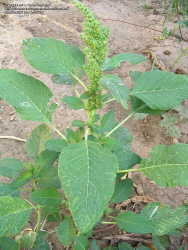
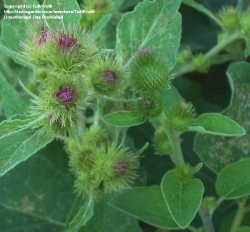
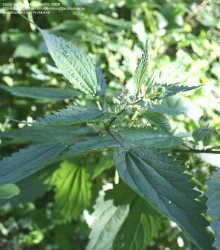 Pigweed
Pigweed
Some plants’ roots (like corn) will piggy-back on the weed roots, going deeper into the soil than normal, giving those roots direct access to water and micronutrients not available in the topsoil. My neighbor, an old-timer, has Lamb’s Quarters and Pigweed growing between his tomato rows. I thought he was just tired of weeding. “Nope,” he said. “They help the t’mater roots reach water and fert’lizer deep in the dirt. B’sides, you can eat ‘em. Ain’t a better eatin’ mess o’ greens.” To be fair in telling my tale, Buster’s tomato patch was NOT over-run with weeds. He had thinned the weeds with somewhat more spacing than the tomato plants, telling me that weeds needed to be controlled rather than eradicated. He allows only a few of the weeds to set seed for the following year, and has been known to transplant appropriate weeds into a new potato patch to open up the soil even though folks thought he was crazy.
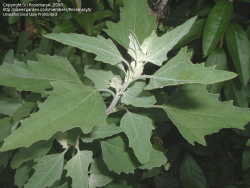
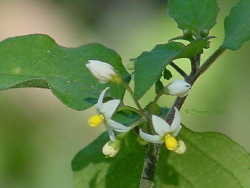
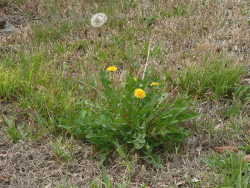 Lamb's Quarters
Lamb's Quarters
Joseph A. Cocannouer, in Weeds, Guardians of the Soil, mentions many beneficial weeds with deep root systems. A few are: nightshades, purslane, ragweeds, stinging nettle, sow thistle, and milkweed along with the lamb’s quarters and pigweed my neighbor was using.[2] Weeds really help break up hardpan, basically because the roots exude a substance which softens the compact soils so that roots can penetrate deeper, doing their job of moving nutrients.[3] It also makes sense to me that weeds with deep root systems are great for erosion control. I only have to look at the steep but stable hillside just behind my house; it has a good crop of thistles, milkweed and pokeweed.
Certain weeds can indicate specific deficiencies in the soil. However, do not rely on just a weed type or two growing as the sole soil indicators without also taking a soil sample. Weeds have a way of growing where they shouldn’t. “Scientists have found that wild daisies grow in lawns that are deficient in lime. The daisies somehow collect or manufacture and store lime in their tissue. When the daisies die, the lime is deposited in the topsoil. This continues until the lime becomes sufficient for the lawn, then the wild daisies disappear.”[3] “Goldenrod prefer wet soil, dandelions like it rich and chickweed go for previously cultivated sites.”[4] “Burdock grows in soils with very high levels of iron and sulfate, very low levels of calcium and manganese.” [5]
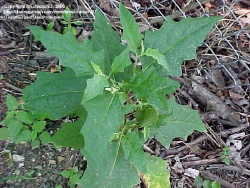
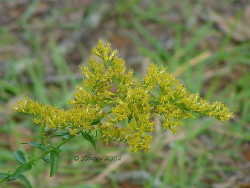
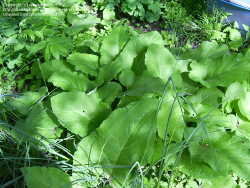 Horse Nettle
Horse Nettle
Some Weeds as Soil Indicators
“Poor soil with low humus: Sheep sorrel (Rumex acetosella), dog fennel (Eupatorium capillifolium), broom sedge (Andropogon virginicus), yellow toadflax (Linaria vulgaris).
Alkaline soil: goosefoot (Chenopodium species), true chamomile (Anthemis nobilis), bladder campion (Silene latifolia).
Acid soil: Ox-eye daisy (Chrysanthemum leucanthemum), curly dock (Rumex crispus), sheep sorrel (Rumex acetosella), sow thistle (Sonchus species), wild strawberries (Fragaria species), plantain (Plantago major), rough cinquefoil (Potentilla monspeliensis).
Heavy soil: Wild garlic (Allium vineale), dandelion (Taraxacum officinale), broadleaf dock (Rumex obtusifolius), plantain (Plantago major).
Soil with a hardpan or hard crust: Horse nettle (Solanum carolinense), quack grass (Agropyron repens), field mustard (Brassica nigra), morning-glory (Ipomoea purpurea). [4]
There are more soil indicators listed in the article quoted above.
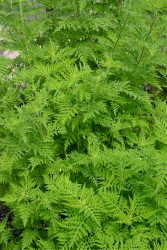 Jay McCaman says,“Balance the soil, lose the weed." [5] What weeds teach me is that healthy, balanced soil will not sustain weeds, but that I can use weeds now to begin to improve and balance my soil. Learning about balancing our soils can be a daunting task; there are so many different schools of thought on the subject. The chemical companies of course push more and more synthetic fertilizers, along with herbicides and pesticides which kill the living, breathing organism we know as SOIL. Most of us think “organic” merely means the cessation of synthetic chemical usage on our gardens and farms. In actuality, it takes much more than that to have healthy soil, producing healthy vegetables, fruit and pasture to feed healthy human beings and healthy animals.
Jay McCaman says,“Balance the soil, lose the weed." [5] What weeds teach me is that healthy, balanced soil will not sustain weeds, but that I can use weeds now to begin to improve and balance my soil. Learning about balancing our soils can be a daunting task; there are so many different schools of thought on the subject. The chemical companies of course push more and more synthetic fertilizers, along with herbicides and pesticides which kill the living, breathing organism we know as SOIL. Most of us think “organic” merely means the cessation of synthetic chemical usage on our gardens and farms. In actuality, it takes much more than that to have healthy soil, producing healthy vegetables, fruit and pasture to feed healthy human beings and healthy animals.
You can start building healthy soil with weeds.
I have been delighted to see lamb’s-quarter and purslane growing around the green beans and herbs in my new vegetable patch. Other low-growing weeds I haven’t yet identified are providing a cooling groundcover and holding in moisture since I haven’t had any mulch available. I have never grown much in the way of legumes before, but the few that I tried without an inoculant still grew, so I figured I didn’t really need to buy yet another item. I am finally understanding the inoculant is actually for the benefit of the soil first (fixing nitrogen) and only then for my beans. I heard several years ago that daikon radish will help break up clay soil, and now I realize that it is because of the same mechanism of deep roots helping the upward movement of nutrients. Daikon will be planted in my garden next year for sure!
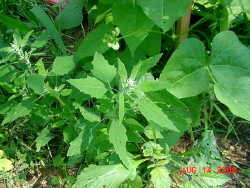
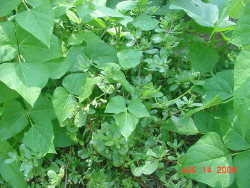
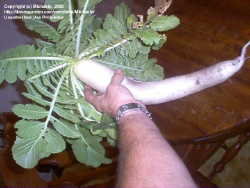 Lamb's Quarters growing with Beans
Lamb's Quarters growing with BeansTo improve MY soil, I will be buying and spreading natural amendments including composted manure along with the green manure from my weeds (cut just at the flowering stage for the most nutrition) and kitchen compost to my vegetable plot. It will take some time, but in the meantime my good weeds will be working away in my garden, building highways for nutrients and breaking up my soil!
Footnotes
Photo Credits: Thanks to Poppysue (Chicory), Floridian (Dandelion, Black Nightshade, Goldenrod), GardenGuyKin (Stinging Nettle), Creekwalker (Burdock), chicochi3 (Horse Nettle), Xenomorf (Pigweed), Michaelp (Daikon), Melody (Ragweed), the dear, late TuttiFrutti (Burdock Flower), and RosemaryA (Lamb's Quarters) for the use of their photos from PlantFiles. The other photos are the author's.
Copyright © www.100flowers.win Botanic Garden All Rights Reserved